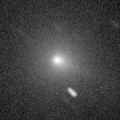
|
Now it is bright as 8.2 mag (Sept. 16, Juan Jose Gonzalez). It is expected to brighten up to 7.5 mag in October. In the Northern Hemisphere, it stays observable in excellent condition for a long time. In the Southern Hemisphere, it is getting lower gradually, and it will be unobservable for a long time after October.
Date(TT) R.A. (2000) Decl. Delta r Elong. m1 Best Time(A, h)
Sept.23 4 13.83 26 45.9 0.822 1.529 113 7.9 4:07 ( 0, 82)
Sept.30 4 23.32 34 1.3 0.773 1.513 116 7.7 3:49 ( 0, 89)
|

|
It brightened up to 7.1 mag from May to June (June 21, Juan Jose Gonzalez). Now it is fading. It has already faded down to 10.9 mag (Sept. 22, Chris Wyatt). In the Southern Hemisphere, it is observable in good condition after this. It will never be observable again in the Northern Hemisphere.
Date(TT) R.A. (2000) Decl. Delta r Elong. m1 Best Time(A, h)
Sept.23 16 1.60 -50 40.7 2.207 2.120 71 10.7 19:20 ( 30, -7)
Sept.30 16 19.69 -52 9.3 2.321 2.177 69 10.9 19:09 ( 29, -8)
|
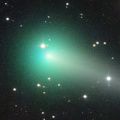
|
It brightened up to 6.2 mag in April (Apr. 7, Juan Jose Gonzalez). Now it is fading. It has already faded down to 12.6 mag (Sept. 16, Carlos Labordena). It stays observable for a long time after this.
Date(TT) R.A. (2000) Decl. Delta r Elong. m1 Best Time(A, h)
Sept.23 3 56.53 22 54.1 1.664 2.313 118 11.2 3:50 ( 0, 78)
Sept.30 3 52.78 22 31.2 1.666 2.395 125 11.4 3:19 ( 0, 78)
|
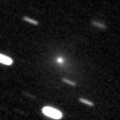
|
Now it is 13.4 mag (Sept. 2, Toshiyuki Takahashi). It will stay bright as 10 mag for a long time from winter to next spring. In the Southern Hemisphere, it stays observable in good condition until next February. In the Northern Hemispehre, it stays observable for a long time after this until the comet fades out.
Date(TT) R.A. (2000) Decl. Delta r Elong. m1 Best Time(A, h)
Sept.23 5 34.27 -2 19.0 3.259 3.514 96 12.0 4:24 (335, 50)
Sept.30 5 35.98 -1 58.1 3.117 3.468 102 11.9 4:29 (347, 52)
|
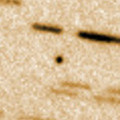
|
Now it is 17.5 mag (Aug. 6, Jean-Francois Soulier). It will pass the perihelion on Oct. 27. In the Southern Hemisphere, it stays observable while the comet will be brightening, until early October when the comet will brighten up to 9 mag. In the Northern Hemisphere, it is not observable at all in this apparition.
Date(TT) R.A. (2000) Decl. Delta r Elong. m1 Best Time(A, h)
Sept.23 13 46.85 -55 16.3 1.048 1.018 59 12.9 19:20 ( 39,-26)
Sept.30 13 44.33 -50 50.7 1.020 0.870 50 12.0 19:09 ( 45,-27)
|
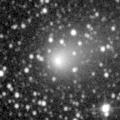
|
It brightened up to 10 mag from spring to summer. Now it is fading. It has already faded down to 12.2 mag (Sept. 22, Chris Wyatt). It is observable in excellent condition in the Southern Hemisphere. It locates low in the Northern Hemisphere.
Date(TT) R.A. (2000) Decl. Delta r Elong. m1 Best Time(A, h)
Sept.23 18 54.72 -35 38.5 1.283 1.775 101 12.2 19:20 ( 7, 19)
Sept.30 19 11.96 -34 48.2 1.367 1.805 98 12.4 19:09 ( 7, 20)
|
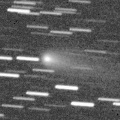
|
It brightened up to 12.2 mag in August (Aug. 21, Juan Jose Gonzalez). It will be fading after this. It has already faded down to 13.9 mag (Sept. 21, Chris Wyatt).
Date(TT) R.A. (2000) Decl. Delta r Elong. m1 Best Time(A, h)
Sept.23 7 15.25 11 15.8 1.481 1.502 71 12.3 4:24 (292, 46)
Sept.30 7 29.18 10 57.2 1.476 1.551 74 12.5 4:29 (297, 49)
|
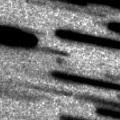
|
Now it is 15.8 mag (Sept. 2, Ken-ichi Kadota). It will brighten very rapidly, and brighten up to 10 mag from October to December. It is observable in good condition in the Northern Hemisphere. It locates very low for a long time in the Southern Hemisphere.
Date(TT) R.A. (2000) Decl. Delta r Elong. m1 Best Time(A, h)
Sept.23 8 31.96 20 33.2 1.713 1.399 54 13.7 4:24 (269, 36)
Sept.30 8 59.78 19 39.6 1.653 1.357 55 13.1 4:29 (270, 36)
|

|
Outburst occured on Aug. 27. Now it is very bright as 11.9 mag (Sept. 22, Chris Wyatt).
Date(TT) R.A. (2000) Decl. Delta r Elong. m1 Best Time(A, h)
Sept.23 21 6.42 -14 45.3 5.068 5.818 134 13.3 20:57 ( 0, 40)
Sept.30 21 5.10 -14 47.2 5.152 5.817 127 13.3 20:28 ( 0, 40)
|
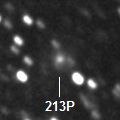
|
Now it is bright as 13.5 mag (Aug. 14, Chris Wyatt). It was expected to brighten up to 12 mag in summer. But actually, it is fainter than expected. It is observable in excellent condition in the Southern Hemisphere. It locates somewhat low in the Northern Hemisphere.
Date(TT) R.A. (2000) Decl. Delta r Elong. m1 Best Time(A, h)
Sept.23 19 14.49 -21 5.6 1.437 1.984 107 13.6 19:20 ( 4, 34)
Sept.30 19 23.66 -20 9.6 1.505 1.984 102 13.8 19:09 ( 6, 35)
|
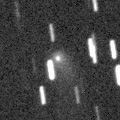
|
Now it is 14.8 mag (Aug. 21, Gabor Santa). In the Northern Hemisphere, it will brighten up to 14 mag from summer to winter, and it will be observable in excellent condition. It is not observable at all after this in the Southern Hemisphere.
Date(TT) R.A. (2000) Decl. Delta r Elong. m1 Best Time(A, h)
Sept.23 22 1.61 70 49.2 2.765 3.200 106 13.8 21:49 (180, 54)
Sept.30 21 29.39 70 49.4 2.773 3.202 106 13.8 20:49 (180, 54)
|
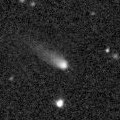
|
It brightened up to 12.3 mag in August (Aug. 16, Juan Jose Gonzalez). It will be fading after this. It has already faded down to 14.6 mag (Sept. 10, Thomas Lehmann).
Date(TT) R.A. (2000) Decl. Delta r Elong. m1 Best Time(A, h)
Sept.23 19 51.14 -7 57.1 2.120 2.733 117 13.8 19:41 ( 0, 47)
Sept.30 19 37.91 -9 52.3 2.269 2.741 107 14.0 19:09 ( 3, 45)
|
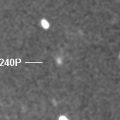
|
It brightened very rapidly from July to August. Now it is very bright as 14.0 mag (Sept. 15, Chris Wyatt). It is observable in excellent condition in the Southern Hemisphere. It stays low for a while in the Northern Hemisphere.
Date(TT) R.A. (2000) Decl. Delta r Elong. m1 Best Time(A, h)
Sept.23 0 25.12 -36 14.5 1.887 2.758 143 14.6 0:19 ( 0, 19)
Sept.30 0 18.67 -36 29.7 1.878 2.728 140 14.4 23:40 ( 0, 19)
|
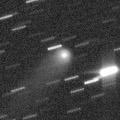
|
Now it is 14.2 mag (Sept. 22, Sandor Szabo). It will be observable at 14 mag for a long time from 2017 to 2018. In the Southern Hemisphere, it will be unobservable in early October. It will be extremely low from November to December in the Northern Hemisphere.
Date(TT) R.A. (2000) Decl. Delta r Elong. m1 Best Time(A, h)
Sept.23 16 7.16 20 16.4 4.297 3.957 63 14.6 19:20 ( 85, 43)
Sept.30 16 6.51 19 52.7 4.360 3.937 58 14.7 19:09 ( 88, 40)
|
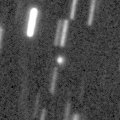
|
Now it is 13.7 mag (Sept. 22, Sandor Szabo). It is expected to brighten up to 11-12 mag from 2018 to 2019. In the Northern Hemisphere, it stays observable in good condition while the comet will be brightening gradually. In the Southern Hemisphere, it is not observable until 2018 October.
Date(TT) R.A. (2000) Decl. Delta r Elong. m1 Best Time(A, h)
Sept.23 14 53.44 50 29.6 4.384 4.020 62 14.8 19:20 (130, 39)
Sept.30 14 54.56 49 38.4 4.351 3.971 61 14.7 19:09 (130, 36)
|
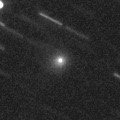
|
Now it is 14.5 mag (Sept. 22, Sandor Szabo). It is expected to brighten up to 9 mag in summer in 2018. In the Northern Hemisphere, it stays observable until 2018 summer while the comet will be brightening. In the Southern Hemisphere, it is hardly observable in 2017, but it will be observable in good condition in 2018.
Date(TT) R.A. (2000) Decl. Delta r Elong. m1 Best Time(A, h)
Sept.23 17 4.44 31 34.2 4.185 4.100 78 14.8 19:20 ( 94, 60)
Sept.30 17 6.37 29 24.6 4.196 4.043 74 14.8 19:09 ( 92, 56)
|

|
Now it is 13-13.5 mag (Aug. 18, Gabor Santa). It will be unobservable in late October in the Northerm Hemisphere, or in late November in the Southern Hemisphere.
Date(TT) R.A. (2000) Decl. Delta r Elong. m1 Best Time(A, h)
Sept.23 16 34.73 -26 8.1 3.080 2.913 71 14.8 19:20 ( 40, 16)
Sept.30 16 44.32 -26 31.3 3.164 2.911 66 14.9 19:09 ( 41, 15)
|
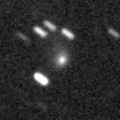
|
Now it is 15.3 mag (Aug. 22, Kunihiro Shima). It stays observable at 16 mag for a long time from 2017 to 2018.
Date(TT) R.A. (2000) Decl. Delta r Elong. m1 Best Time(A, h)
Sept.23 1 57.09 23 52.4 3.484 4.326 142 15.1 1:51 ( 0, 79)
Sept.30 1 46.90 22 16.6 3.406 4.317 152 15.0 1:13 ( 0, 77)
|
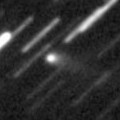
|
Now it is 15.7 mag (Sept. 13, Martin Masek). It will brighten up to 14.5 mag in winter. In the Southern Hemisphere, it stays observable in excellent condition until spring in 2018. In the Northern Hemisphere, it stays unobservable until 2018.
Date(TT) R.A. (2000) Decl. Delta r Elong. m1 Best Time(A, h)
Sept.23 3 29.48 -80 47.6 2.025 2.346 95 15.2 3:21 ( 0,-26)
Sept.30 3 18.55 -80 59.4 2.010 2.305 93 15.1 2:43 ( 0,-26)
|
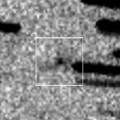
|
Now it is 18.5 mag (Aug. 13, Francois Kugel). It brightens rapidly, and brightens up to 11 mag from autumn to winter. It is observable in good condition in the Northern Hemisphere. It locates low in the Southern Hemisphere.
Date(TT) R.A. (2000) Decl. Delta r Elong. m1 Best Time(A, h)
Sept.23 7 57.92 19 20.4 1.689 1.510 62 16.0 4:24 (275, 42)
Sept.30 8 22.08 18 47.1 1.628 1.481 63 15.3 4:29 (277, 44)
|

|
Now it is 15.4 mag (Aug. 19, Gabor Santa). It stays observable at 16 mag unil the end of 2017.
Date(TT) R.A. (2000) Decl. Delta r Elong. m1 Best Time(A, h)
Sept.23 3 39.35 2 6.3 5.343 5.976 125 15.4 3:33 ( 0, 57)
Sept.30 3 38.73 1 40.4 5.293 6.004 131 15.4 3:04 ( 0, 57)
|

|
Now it is 15.4 mag (Sept. 2, Ken-ichi Kadota). It brightened rapidly. It is observable at 15 mag in autumn in good condition in the Northern Hemisphere. It locates low in the Southern Hemisphere.
Date(TT) R.A. (2000) Decl. Delta r Elong. m1 Best Time(A, h)
Sept.23 5 5.58 28 7.6 1.437 1.915 101 15.7 4:24 (310, 80)
Sept.30 5 15.60 29 21.6 1.383 1.923 106 15.5 4:29 (336, 84)
|
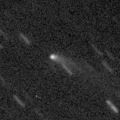
|
Now it is 16.4 mag (Aug. 26, Toshiyuki Takahashi). It was observed at 17 mag in 2016. In 2017, it will be observable at 15.5 mag in good condition from summer to autumn. It is fainter than this ephemeris recently.
Date(TT) R.A. (2000) Decl. Delta r Elong. m1 Best Time(A, h)
Sept.23 1 34.77 17 38.8 1.964 2.882 150 15.6 1:29 ( 0, 73)
Sept.30 1 29.99 17 51.8 1.937 2.890 157 15.6 0:56 ( 0, 73)
|
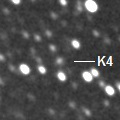
|
Now it is 15.5 mag (Aug. 9, Yuji Ohshima). It stays 16 mag for a long time until summer in 2018. In the Southern Hemisphere, it stays observable in excellent condition until autumn. It locates low in the Northern Hemisphere.
Date(TT) R.A. (2000) Decl. Delta r Elong. m1 Best Time(A, h)
Sept.23 17 24.37 -28 5.1 2.813 2.856 82 15.8 19:20 ( 29, 20)
Sept.30 17 33.72 -27 31.5 2.875 2.831 77 15.8 19:09 ( 31, 20)
|
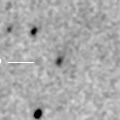
|
First return of a new periodic comet discovered in 2000. Now it is 16.3 mag (Aug. 26, Toshiyuki Takahashi). It will brighten rapidly, and it was expected to be observable at 15.5 mag in good condition from July to September. But actually, it is fainter than this ephemeris.
Date(TT) R.A. (2000) Decl. Delta r Elong. m1 Best Time(A, h)
Sept.23 0 59.92 -7 23.6 1.679 2.655 163 16.0 0:54 ( 0, 48)
Sept.30 0 53.95 -6 54.4 1.686 2.673 167 16.1 0:20 ( 0, 48)
|
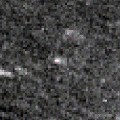
|
Now it is 16.8 mag (Sept. 13, Martin Masek). Return of a new periodic comet which brightened up to 13 mag in 2004. It will be observable in excellent condition in autumn. It was expected to brighten up to 14 mag, if the comet is as bright as when it was discovered. But actually, it is much fainter than expected.
Date(TT) R.A. (2000) Decl. Delta r Elong. m1 Best Time(A, h)
Sept.23 2 45.35 2 36.0 0.841 1.726 138 16.7 2:39 ( 0, 58)
Sept.30 2 46.49 3 29.0 0.803 1.720 144 16.6 2:12 ( 0, 59)
|

|
Now it is 16.0 mag (Aug. 22, Kunihiro Shima). It stays 16 mag from 2016 to 2017. In the Northern Hemisphere, it stays observable in good condition for a long time. In the Southern Hemisphere, it will never be observable again.
Date(TT) R.A. (2000) Decl. Delta r Elong. m1 Best Time(A, h)
Sept.23 17 50.87 62 42.2 6.486 6.545 88 16.6 19:20 (159, 58)
Sept.30 17 54.30 62 9.5 6.503 6.559 88 16.7 19:09 (156, 58)
|
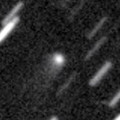
|
It stays 16 mag for a long time from 2017 to 2018. It is observable in excellent condition in the Northern Hemisphere. It locates very low in the Southern Hemisphere.
Date(TT) R.A. (2000) Decl. Delta r Elong. m1 Best Time(A, h)
Sept.23 9 9.66 19 2.5 5.998 5.347 45 16.7 4:24 (265, 27)
Sept.30 9 12.06 19 33.0 5.897 5.343 52 16.6 4:29 (269, 34)
|
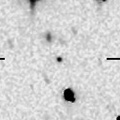
|
It will be observable at 16.5 mag in good condition in winter.
Date(TT) R.A. (2000) Decl. Delta r Elong. m1 Best Time(A, h)
Sept.23 8 33.75 12 13.0 3.143 2.655 52 16.9 4:24 (277, 31)
Sept.30 8 44.52 10 38.5 3.080 2.660 56 16.9 4:29 (282, 35)
|
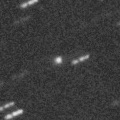
|
Now it is 17.1 mag (Sept. 2, Toshiyuki Takahashi). It is expected to brighten up to 13-14 mag from 2018 to 2019. In the Northern Hemisphere, it stays observable in good condition for a long time. In the Southern Hemisphere, it is not observable until summer in 2018.
Date(TT) R.A. (2000) Decl. Delta r Elong. m1 Best Time(A, h)
Sept.23 18 32.92 60 39.0 5.266 5.430 94 17.0 19:20 (165, 63)
Sept.30 18 29.13 58 49.7 5.240 5.384 92 16.9 19:09 (158, 63)
|

|
Now it is 17.9 mag (June 2, MASTER-OAFA Observatory). It will brighten up to 14 mag from autumn to winter in 2018, and it will be observable in excellent condition in the Northern Hemisphere. In 2017, it is observable at 17 mag in excellent condition in the Southern Hemisphere.
Date(TT) R.A. (2000) Decl. Delta r Elong. m1 Best Time(A, h)
Sept.23 23 37.22 -46 12.6 3.200 3.959 133 17.0 23:26 ( 0, 9)
Sept.30 23 28.99 -45 51.3 3.198 3.916 129 17.0 22:51 ( 0, 9)
|
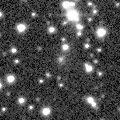
|
It will pass the perihelion in 2019. However, it has not been brightening since the discovery in 2010. It is observable in good conditioin in the Northern Hemisphere. It is not observable for a long time in the Southern Hemisphere.
Date(TT) R.A. (2000) Decl. Delta r Elong. m1 Best Time(A, h)
Sept.23 6 47.96 68 23.7 9.008 8.986 85 17.0 4:24 (200, 51)
Sept.30 6 52.70 69 4.2 8.916 8.972 90 17.0 4:29 (196, 53)
|
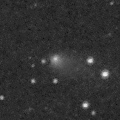
|
Hilda-type minor planet, but the cometary activity was detected on July 3. Now it is bright as 16.2 mag (Aug. 22, Kunihiro Shima).
Date(TT) R.A. (2000) Decl. Delta r Elong. m1 Best Time(A, h)
Sept.23 20 50.81 -2 30.8 2.712 3.472 132 17.1 20:41 ( 0, 53)
Sept.30 20 50.79 -3 12.8 2.804 3.490 126 17.2 20:14 ( 0, 52)
|

|
Now it is 18.0 mag (Aug. 22, Kunihiro Shima). In the Northern Hemisphere, it will be observable at 17 mag in excellent condition from autumn to winter. It locates low in the Southern Hemisphere.
Date(TT) R.A. (2000) Decl. Delta r Elong. m1 Best Time(A, h)
Sept.23 5 30.15 31 33.3 2.774 3.051 96 17.2 4:24 (281, 77)
Sept.30 5 35.37 32 4.2 2.695 3.063 101 17.1 4:29 (292, 83)
|
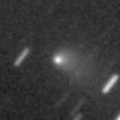
|
Now it is 15.8 mag (Sept. 2, Ken-ichi Kadota). It is observable in excellent condition in the Southern Hemisphere. It will be getting higher gradually in the morning sky also in the Northern Hemisphere. It will fade out rapidly after this.
Date(TT) R.A. (2000) Decl. Delta r Elong. m1 Best Time(A, h)
Sept.23 21 5.88 -17 41.6 1.804 2.601 133 17.2 20:56 ( 0, 38)
Sept.30 21 5.64 -15 58.5 1.893 2.624 127 17.3 20:29 ( 0, 39)
|
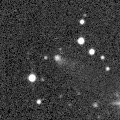
|
It was observed at 17 mag in 2016. It stays 17 mag also in 2017. It is observable in good condition in the Northern Hemisphere. It locates very low in the Southern Hemisphere.
Date(TT) R.A. (2000) Decl. Delta r Elong. m1 Best Time(A, h)
Sept.23 6 55.71 33 10.9 2.987 2.952 78 17.3 4:24 (263, 60)
Sept.30 7 3.55 33 22.4 2.917 2.974 83 17.3 4:29 (265, 65)
|
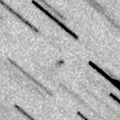
|
Now it is 19.3 mag (Aug. 23, Michael Jager). It is observable in good condition. But actually, it is much fainter than this ephemeris.
Date(TT) R.A. (2000) Decl. Delta r Elong. m1 Best Time(A, h)
Sept.23 19 9.45 15 6.8 0.643 1.339 106 17.6 19:20 ( 13, 70)
Sept.30 19 31.31 15 52.8 0.697 1.375 106 17.8 19:09 ( 10, 71)
|

|
It brightened up to 11 mag from spring to summer in 2016. Now it is 17.4 mag (July 14, Ken-ichi Kadota). It stays observable for a long time after this, but it will be fainter than 18 mag in October.
Date(TT) R.A. (2000) Decl. Delta r Elong. m1 Best Time(A, h)
Sept.23 19 30.98 -21 7.4 3.182 3.667 111 17.8 19:22 ( 0, 34)
Sept.30 19 32.72 -21 7.9 3.315 3.699 104 17.9 19:09 ( 4, 34)
|

|
Peculiar asteroid moving along a comet-like orbit. It is observable at 18 mag in good condition from August to September. It locates somewhat low in the Southern Hemisphere.
Date(TT) R.A. (2000) Decl. Delta r Elong. m1 Best Time(A, h)
Sept.23 22 20.15 17 29.0 2.864 3.765 149 17.8 22:10 ( 0, 73)
Sept.30 22 17.42 17 9.0 2.899 3.767 145 17.9 21:40 ( 0, 72)
|
|
![]()
 47P/Ashbrook-Jackson
47P/Ashbrook-Jackson C/2017 K4 ( ATLAS )
C/2017 K4 ( ATLAS ) 352P/2017 L1 ( Skiff )
352P/2017 L1 ( Skiff ) 355P/2017 M2 ( LINEAR-NEAT )
355P/2017 M2 ( LINEAR-NEAT ) C/2014 OE4 ( PanSTARRS )
C/2014 OE4 ( PanSTARRS ) C/2016 A1 ( PanSTARRS )
C/2016 A1 ( PanSTARRS ) C/2016 T3 ( PanSTARRS )
C/2016 T3 ( PanSTARRS ) C/2017 M4 ( ATLAS )
C/2017 M4 ( ATLAS ) (944) Hidalgo
(944) Hidalgo C/2010 U3 ( Boattini )
C/2010 U3 ( Boattini ) (457175) 2008 GO98
(457175) 2008 GO98 90P/Gehrels 1
90P/Gehrels 1 C/2017 D2 ( Barros )
C/2017 D2 ( Barros ) 188P/LINEAR-Mueller
188P/LINEAR-Mueller 189P/NEAT
189P/NEAT 81P/Wild 2
81P/Wild 2 2016 ND21
2016 ND21![]()


































